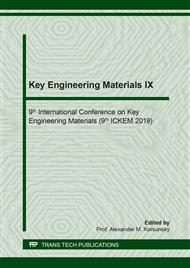[1]
Y. Yoshizawa, S. Oguma, K. Yamauchi, New Fe-based soft magnetic alloys composed of ultrafine grain structure, J. Appl. Phys. 64 (1988) 6044–6046.
DOI: 10.1063/1.342149
Google Scholar
[2]
K. Hono, K. Hiraga, Q. Wang, A. Inoue, T. Sakurai, The microstructure evolution of a Fe73.5Si13.5B9Nb3Cu1 nanocrystalline soft magnetic material, Acta Metall. Mater. 40 (1992) 2137–2147.
DOI: 10.1016/0956-7151(92)90131-w
Google Scholar
[3]
Y. Yoshizawa, K. Yamauchi, Magnetic properties of Fe-Cu-M-S-B (M = Cr, V, Nb, Ta, W) alloys, Mater. Sci. Eng. 133A (1991) 176–179.
DOI: 10.1016/b978-0-444-89107-5.50045-9
Google Scholar
[4]
K. Yamauchi, Y. Yoshizawa, Recent development of nanocrystalline soft magnetic alloys, NanoStructured Mater. 6 (1995) 247–254.
DOI: 10.1016/0965-9773(95)00048-8
Google Scholar
[5]
M. Müller, N. Mattern, U. Kühn, Correlation between magnetic and structural properties of nanocrystalline soft magnetic alloys, J. Magn. Magn. Mater. 157–158 (1996) 209–210.
DOI: 10.1016/0304-8853(95)01082-3
Google Scholar
[6]
G. Herzer, Amorphous and nanocrystalline soft magnets, in: Magnetic hysteresis in novel magnetic materials, Ed. G.C. Hadjipanayis, Kluver Academic Publishers, 1997, p.711–730.
DOI: 10.1007/978-94-011-5478-9_77
Google Scholar
[7]
H. H. Liebermann, Aging kinetics of magnetic losses in annealed Fe78B13Si9 amorphous metallic alloy, J. Appl. Phys. 61 (1987) 319–324.
Google Scholar
[8]
Y. Ohta, H. Kakehashi, M. Fukuhara, H. Fukunaga, Long-time aging effect on coercive force in amorphous magnetic cores and estimation of it deterioration at operating temperature, Jap. J. Appl. Phys. 30 (1991) 2765–2769.
DOI: 10.1143/jjap.30.2765
Google Scholar
[9]
S. Bhattacharya, E.A. Lass, S.J. Poon, G.J. Shiflet, M. Rawlings, M. Daniil, M.A. Willard, Magnetic properties and thermal stability of (Fe,Co)-Mo-B-P-Si metallic glasses, J. Appl. Phys. 111 (2012) 063906.
DOI: 10.1063/1.3692389
Google Scholar
[10]
Yu.N. Starodubtsev, V.Ya. Belozerov, Magnetic properties of amorphous and nanocrystalline alloys, Yekaterinburg, 2002 (in Russian).
Google Scholar
[11]
A. Lekdim, L. Morel, M.-A. Raulet, Magnetic properties evolution of a high permeability nanocrystalline FeCuNbSiB during thermal ageing, Eur. Phys. J. Phys. 79 (2017) 20601.
DOI: 10.1051/epjap/2017160449
Google Scholar
[12]
A. Lekdim, L. Morel, M.-A. Raulet, Effect of the remaining magnetization on the thermal ageing of high permeability nanocrystalline FeCuNbSiB alloys, J. Magn. Magn. Mater. 460 (2018) 253–262.
DOI: 10.1016/j.jmmm.2018.03.051
Google Scholar
[13]
B.N. Filippov, V.V. Shulika, A.P. Potapov, N.F. Viľdanova, Magnetic properties and temperature stability of a molybdenum-doped Finemet-type alloy, Techn. Phys. 59 (2014) 373–377.
DOI: 10.1134/s1063784214030098
Google Scholar
[14]
O. Kubaschewski, Iron–binary phase diagrams, Springer–Verlag, Berlin, (1982).
Google Scholar
[15]
Phase diagrams of binary metallic systems, Vol. 2, Ed. N.P. Lyakishev, Moscow, 1997 (In Russian).
Google Scholar
[16]
N.N. Greenwood, A. Earnshaw, Chemistry of the elements, Butterworth–Heinemann, Oxford, (1998).
Google Scholar
[17]
W. Hume-Rothery, G.V. Raynor, The structure of metals and alloys, The institute of metals, London, (1962).
Google Scholar
[18]
G. Gottstein, L.S. Shvindlerman, Grain boundary migration in metals: thermodynamics, kinetics, applications, CRC Press, Boca Raton, London, New York, (2010).
DOI: 10.1201/9781420054361
Google Scholar
[19]
K. Hono, D.H. Ping, M. Onhuma, H. Ondera, Cu clustering and Si partitioning in the early crystallization stage of an Fe73.5Si13.5B9Nb3Cu1 amorphous alloy, Acta Mater. 47 (1999) 997–1006.
DOI: 10.1016/s1359-6454(98)00392-9
Google Scholar
[20]
M.M. Gong, F. Liu, K. Zhang, Thermodynamic stability of binary nanocrystalline alloys: analysis of solute and excess vacancy, Appl. Phys. A 105 (2011) 927–934.
DOI: 10.1007/s00339-011-6501-2
Google Scholar
[21]
V.S. Tsepelev, Yu.N. Starodubtsev, V.Ya. Belozerov, The effect of inhibitors on the structure and magnetic properties of nanocrystalline soft magnetic alloys, Phys. Met. Metallogr. 119 (2018) 831–836.
DOI: 10.1134/s0031918x18090120
Google Scholar
[22]
G. Bonny, N. Castin, J. Bullens, A. Bakaev, T.C.P. Klaver, D. Terentyev, On the mobility of vacancy clusters in reduced activation steels: an atomistic study in the Fe-Cr-W model alloy, J. Phys.: Condens. Matter. 25 (2013) 315401.
DOI: 10.1088/0953-8984/25/31/315401
Google Scholar
[23]
A. Kedous-Lebouc, P. Brissonneau, Accelerated aging behaviour under a compressive stress of Metglass 2605S2 amorphous ribbons, Phys. Scripta 39 (1989) 112–114.
DOI: 10.1088/0031-8949/39/1/018
Google Scholar
[24]
V.A. Kataev, Yu.N. Starodubtsev, F.V. Mineev, Concerning the magnetic losses in annealed ribbons of amorphous alloy Fe81B13Si4C2// Phys. Met. Metallogr. 70 (1990) 199–202.
Google Scholar


